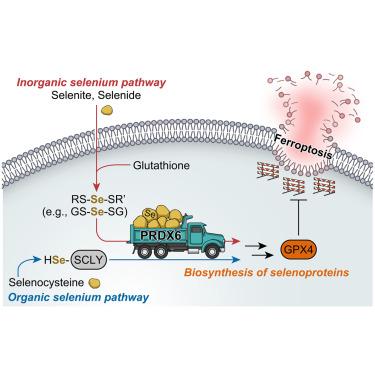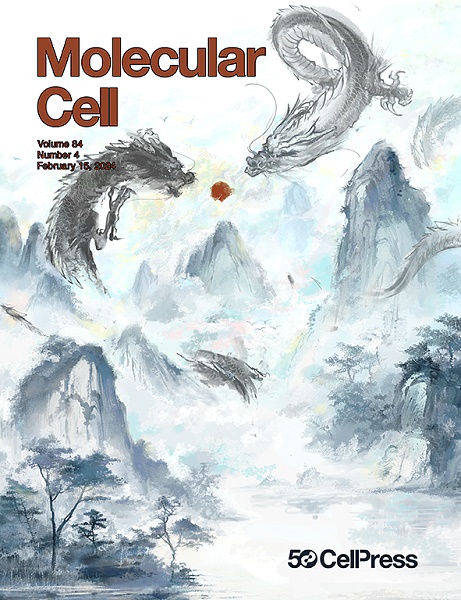PRDX6 通过指导细胞对硒的利用来决定铁中毒的敏感性
IF 14.5
1区 生物学
Q1 BIOCHEMISTRY & MOLECULAR BIOLOGY
引用次数: 0
摘要
依赖硒的谷胱甘肽过氧化物酶 4(GPX4)是铁变态反应的守护者,它通过还原磷脂氢过氧化物(PLOOH)来防止无限制的(磷)脂质过氧化。然而,其他磷脂过氧化物酶对铁变态反应保护的贡献仍不清楚。我们的研究表明,缺乏 GPX4 的细胞仍具有很强的还原 PLOOH 的能力,这表明其他磷脂过氧化物酶也有贡献。通过仔细研究潜在的候选者,我们发现虽然过表达过氧化还原酶6(PRDX6)--一种据报道具有PLOOH还原活性的硫醇特异性抗氧化酶--未能阻止铁猝死,但其基因缺失会使癌细胞对铁猝死敏感。从机理上讲,我们发现PRDX6除了具有已知的过氧化物酶活性外,还可作为硒受体蛋白,促进细胞内硒的利用和硒与硒蛋白(包括GPX4)的有效结合。Prdx6缺陷小鼠大脑中GPX4的表达减少,以及PRDX6缺陷小鼠肿瘤异种移植物对铁卟啉中毒的敏感性增加,都证明了PRDX6的生理意义。我们的研究凸显了 PRDX6 在指导细胞硒利用和决定铁变态反应敏感性方面的关键作用。本文章由计算机程序翻译,如有差异,请以英文原文为准。

PRDX6 dictates ferroptosis sensitivity by directing cellular selenium utilization
Selenium-dependent glutathione peroxidase 4 (GPX4) is the guardian of ferroptosis, preventing unrestrained (phospho)lipid peroxidation by reducing phospholipid hydroperoxides (PLOOH). However, the contribution of other phospholipid peroxidases in ferroptosis protection remains unclear. We show that cells lacking GPX4 still exhibit substantial PLOOH-reducing capacity, suggesting a contribution of alternative PLOOH peroxidases. By scrutinizing potential candidates, we found that although overexpression of peroxiredoxin 6 (PRDX6), a thiol-specific antioxidant enzyme with reported PLOOH-reducing activity, failed to prevent ferroptosis, its genetic loss sensitizes cancer cells to ferroptosis. Mechanistically, we uncover that PRDX6, beyond its known peroxidase activity, acts as a selenium-acceptor protein, facilitating intracellular selenium utilization and efficient selenium incorporation into selenoproteins, including GPX4. Its physiological significance was demonstrated by reduced GPX4 expression in Prdx6-deficient mouse brains and increased sensitivity to ferroptosis in PRDX6-deficient tumor xenografts in mice. Our study highlights PRDX6 as a critical player in directing cellular selenium utilization and dictating ferroptosis sensitivity.
求助全文
通过发布文献求助,成功后即可免费获取论文全文。
去求助
来源期刊

Molecular Cell
生物-生化与分子生物学
CiteScore
26.00
自引率
3.80%
发文量
389
审稿时长
1 months
期刊介绍:
Molecular Cell is a companion to Cell, the leading journal of biology and the highest-impact journal in the world. Launched in December 1997 and published monthly. Molecular Cell is dedicated to publishing cutting-edge research in molecular biology, focusing on fundamental cellular processes. The journal encompasses a wide range of topics, including DNA replication, recombination, and repair; Chromatin biology and genome organization; Transcription; RNA processing and decay; Non-coding RNA function; Translation; Protein folding, modification, and quality control; Signal transduction pathways; Cell cycle and checkpoints; Cell death; Autophagy; Metabolism.
 求助内容:
求助内容: 应助结果提醒方式:
应助结果提醒方式:


